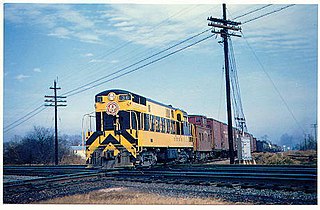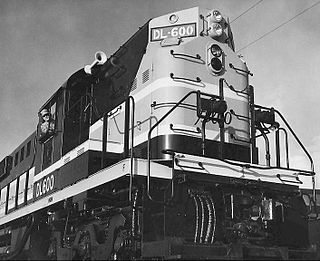
Montreal Locomotive Works (MLW) was a Canadian railway locomotive manufacturer which existed under several names from 1883 to 1985, producing both steam and diesel locomotives. For a number of years it was a subsidiary of the American Locomotive Company. MLW's headquarters and manufacturing facilities were located in Montreal, Quebec.

The Selkirk locomotives were 36 steam locomotives of the 2-10-4 wheel arrangement built for Canadian Pacific Railway by Montreal Locomotive Works, Montreal in Quebec, Canada.

Fairbanks, Morse and Company was an American manufacturing company in the late 19th and early 20th century. Originally a weighing scale manufacturer, it later diversified into pumps, engines, windmills, coffee grinders, radios, farm tractors, feed mills, locomotives, and industrial supplies until it was purchased by Penn Texas in 1958.

The ALCO RS-3 is a 1,600 hp (1.2 MW), B-B road switcher diesel-electric locomotive. It was manufactured by American Locomotive Company (ALCO) and ALCO's subsidiary Montreal Locomotive Works (MLW) from May 1950 to August 1956, and 1,418 were produced — 1,265 for American railroads, 98 for Canadian railroads, 48 for Brazilian and 7 for Mexican railroads. It has a single, 12 cylinder, model 244 engine. The RS-3 was the successor to the RS-2.

The Consolidated line, or C-line, was a series of diesel-electric railway locomotive designs produced by Fairbanks-Morse and its Canadian licensee, the Canadian Locomotive Company. Individual locomotives in this series were commonly referred to as “C-liners”. A combined total of 165 units were produced by F-M and the CLC between 1950 and 1955.

The H-24-66, or Train Master, was a diesel-electric railroad locomotive produced by Fairbanks-Morse and its licensee, Canadian Locomotive Company. These six-axle hood unit road switchers were deployed in the United States and Canada during the 1950s.

The ALCO RS-2 is a 1,500–1,600 horsepower (1,100–1,200 kW) B-B road switcher diesel-electric locomotive built by the American Locomotive Company (ALCO) from 1946 to 1950. ALCO introduced the model after World War II as an improvement on the ALCO RS-1. Between 1946 and 1950, 377 examples of the RS-2 were built, primarily for American and Canadian customers.

The British Rail 4-REP electric multiple-unit passenger trains were built by BR at York Works from 1966 to 1967 and in 1974. The units were built to power the TC trailer units on services on the South West Main Line. Fifteen four-car units were eventually built. The motor coaches were new build, but the trailers were converted from Mk1 hauled stock. They were initially classified as Class 441 and numbered 3001–3015. This was later changed to Class 430, under which they spent the majority of their working lives. Shortly before withdrawal they were reclassified Class 432 and the units were renumbered as 2001–2015. The fleet had a lifespan of 26 years.
The FM H-12-44TS was a light road switcher version of the Fairbanks-Morse H-12-44 yard switcher. Only three of the 1,200-horsepower (890 kW), six-cylinder opposed piston engine locomotives were manufactured especially for the Atchison, Topeka and Santa Fe Railway in May, 1956. The units had an extended frame to accommodate the addition of a short hood behind the cab, and were configured in a B-B wheel arrangement and mounted atop a pair of two-axle AAR Type-A switcher trucks with all axles powered. H-12-44TSs also came equipped with steam generator units as they were acquired solely for shuttling passenger cars in and around the Dearborn Station terminal in Chicago, Illinois.

The FM H-12-44 was a yard switcher produced by Fairbanks-Morse from May, 1950–March, 1961. The units featured a 1,200-horsepower (890 kW), six-cylinder opposed piston engine prime mover, and were configured in a B-B wheel arrangement mounted atop a pair of two-axle AAR Type-A switcher trucks, with all axles powered and geared for a top speed of 60 miles per hour (97 km/h).
The FM H-12-46 was a light road switcher of Fairbanks-Morse design manufactured exclusively by the Canadian Locomotive Company from October, 1951–January, 1953 for the Canadian National Railway. Only thirty of the 1,200 hp, six-cylinder opposed piston engine locomotives were produced. The units were configured in an A1A-A1A wheel arrangement, mounted atop a pair of three-axle trucks.

The FM H-10-44 was a yard switcher produced by Fairbanks-Morse from August, 1944–March, 1950. The units featured a 1,000-horsepower (750 kW), six-cylinder opposed piston prime mover, and were configured in a B-B wheel arrangement mounted atop a pair of two-axle AAR Type A trucks, with all axles powered. Many H-10-44s received modifications that increased their horsepower rating to 1,200 hp (890 kW).

The FM H-16-44 was a road-switcher produced by Fairbanks-Morse from April 1950 – February 1963. The locomotive shared an identical platform and carbody with the predecessor Model FM H-15-44, and were equipped with the same eight-cylinder opposed piston engine that had been uprated to 1,600 horsepower (1,200 kW). The H-16-44 was configured in a B-B wheel arrangement, mounted atop a pair of two-axle AAR Type-B road trucks with all axles powered. In late 1950, the AAR trucks were almost exclusively replaced with the same units found on the company's "C-liner" locomotives.

The ALCO RSD-7 was a diesel-electric locomotive of the road switcher type built by ALCO at Schenectady, New York between January 1954 and April 1956. Two versions were built, with the same RSD-7 model designation but different specifications and power ratings, although both used the ALCO 244 engine in V16 configuration. Specification DL-600, of which only two were built, developed 2,250 hp and used the 244G engine. The revised specification DL-600A, numbering 27 locomotives, was rated at 2,400 hp and used the 244H engine. The RSD-7 was superseded by the ALCO 251-engined ALCO RSD-15, which looks very similar. The RSD-7 was the last ALCO diesel built with a 244 engine.

The FM H-20-44 was a multiple unit-capable end cab road switcher manufactured by Fairbanks-Morse from June 1947 – March 1954, and represented the company's first foray into the road switcher market. The 2,000 hp (1,490 kW), ten-cylinder opposed piston engine locomotive was referred to by F-M's engineering department as the "Heavy Duty" unit. It was configured in a B-B wheel arrangement mounted atop a pair of two-axle AAR Type-B road trucks with all axles powered. H-20-44s shared the same platform and much of the same carbody as the lighter-duty FM H-15-44, which began its production run three months later.
The Erie-built was the first streamlined, cab-equipped dual service diesel locomotive built by Fairbanks-Morse, introduced as direct competition to such models as the ALCO PA and FA and EMD FT. F-M lacked the space and staff to design and manufacture large road locomotives in their own plant at Beloit, Wisconsin, and was concerned that waiting to develop the necessary infrastructure would cause them to miss out on the market opportunity for large road locomotives. Engineering and assembly work was subcontracted out to General Electric, which produced the locomotives at its Erie, Pennsylvania, facility, thereby giving rise to the name "Erie-built."

The P-12-42, also known as the Speed Merchant, was a streamlined, 1,200 hp (890 kW) locomotive built between 1957–1958 by Fairbanks-Morse, specifically to operate on each end of the Talgo train produced by American Car and Foundry. This model represented F-M's attempted entry into the lightweight locomotive market, but only four of the low-slung units were produced: the first pair was purchased by the New York, New Haven and Hartford Railroad for their John Quincy Adams train, while the second pair went to the Boston and Maine Railroad for their Speed Merchant train.
The LS-1000 is a diesel-electric switching locomotive built between May 1949 and April 1950, by Lima Locomotive Works of Lima, Ohio, United States. The LS-1000 is a 1,000 hp switcher, which became the standard for Lima's designs. By changing fuel rack settings, the LS-1000 was upgraded to the LS-1200, producing 1,200 horsepower from the same turbocharged Hamilton T-89-SA four-stroke, eight cylinder inline diesel engine, a Westinghouse generator and four Westinghouse traction motors provided the 74,508 lbf of tractive effort.

The Gulf, Mobile and Northern Railroad Rebels were lightweight, streamlined diesel-electric trains built by American Car and Foundry. The first two trains, purchased in 1935, provided service between New Orleans, Louisiana and Jackson, Tennessee, approximately 450 miles (720 km) The third train, purchased in 1937, allowed service to be added between Jackson, Tennessee, and Mobile, Alabama. Unlike other earlier Diesel streamliners, these trains were not articulated, as their normal operation required adding and removing cars from the consist.
The Fairbanks-Morse 38 8-1/8 is a diesel engine of the two-stroke, opposed-piston type. It was developed in the 1930s, and is similar in arrangement to a contemporary series of German Junkers aircraft diesels. The engine was used extensively in US diesel electric submarines of the 1940s and 1950s, as backup power on most US nuclear submarines, as well as in other marine applications, stationary power generation, and briefly, locomotives. A slightly modified version, the 38ND 8-1/8, continues in service on Los Angeles-, Seawolf-, and Ohio-class nuclear submarines of the US Navy. The 38 8-1/8 has been in continuous production since its development in 1938, and is currently manufactured by a descendant of Fairbanks-Morse, FME, in Beloit, Wisconsin.















